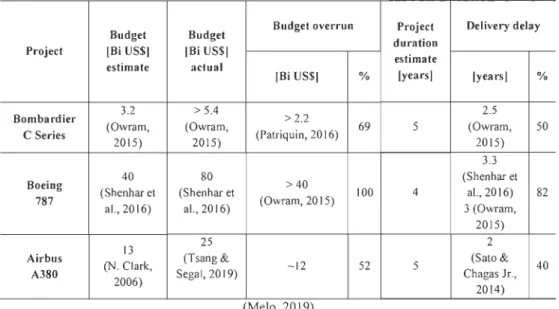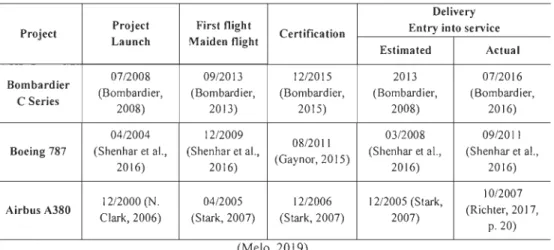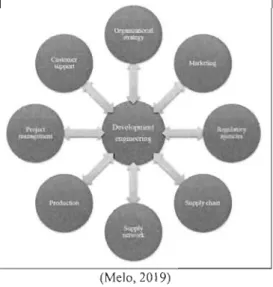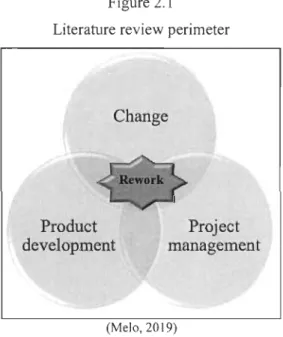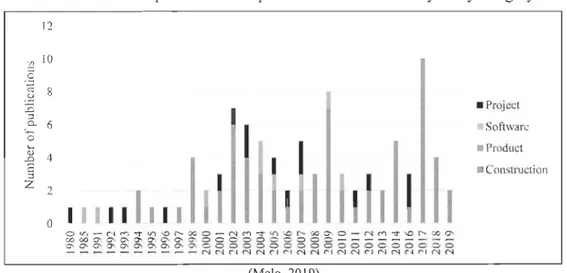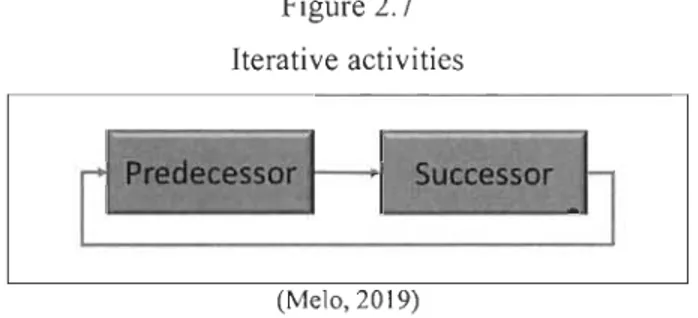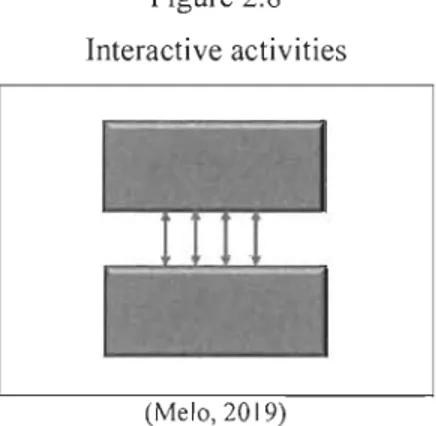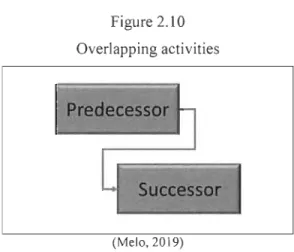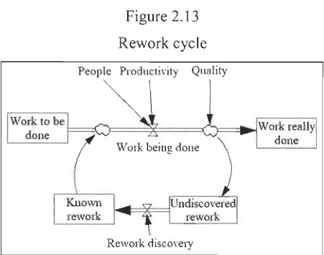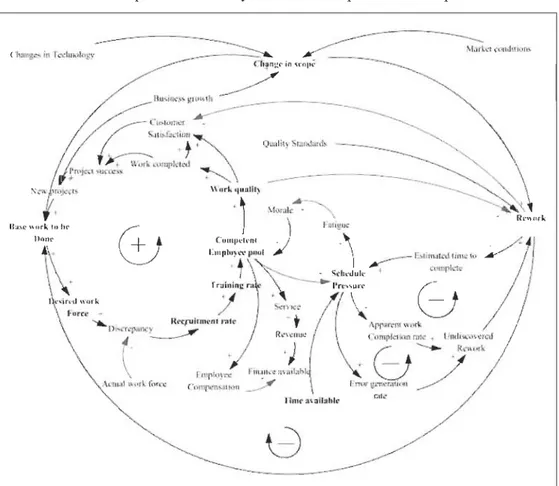LE RETRAVAIL EN CONCEPTION D'INGÉNIERIE DANS LES PROJETS DE DÉVELOPPEMENT DE PRODUIT: LE CAS D'UN FABRICANT D'EQUIPEMENT D'ORIGINE (FEO) CANADIEN
ENGINEERING DESIGN REWORK IN PRODUCT DEVELOPMENT PROJECTS: A CANADIAN OEM CASE STUDY
THÈSE PRÉSENTÉE COMME EXIGENCE PARTIELLE DU
DOCTORAT EN ADMINISTRATION OFFERT CONJOINTEMENT PAR
L'UNIVERSITÉ DU QUÉBEC À TROIS-RIVIÈRES ET L'UNIVERSITÉ DE SHERBROOKE
PAR
ÉRIKA SOUZA DE MELO
Université du Québec à Trois-Rivières
Service de la bibliothèque
Avertissement
L’auteur de ce mémoire ou de cette thèse a autorisé l’Université du Québec
à Trois-Rivières à diffuser, à des fins non lucratives, une copie de son
mémoire ou de sa thèse.
Cette diffusion n’entraîne pas une renonciation de la part de l’auteur à ses
droits de propriété intellectuelle, incluant le droit d’auteur, sur ce mémoire
ou cette thèse. Notamment, la reproduction ou la publication de la totalité
ou d’une partie importante de ce mémoire ou de cette thèse requiert son
autorisation.
Le retravail en conception d'ingénierie dans les projets de développement de produit: le cas d'un fabricant d'équipement d'origine (FEO) canadien
Engineering design rework in product development projects: a Canadian OEM case study
Érika Souza de Melo
Cette thèse a été évaluée par un jury composé des personnes suivantes:
Thang Le Dinh Président du jury
Darli Rodrigues Vieira Directeur de recherche
Christophe Bredillet Codirecteur de recherche
Fabiano Annellini Examinateur externe
Luis Antonio de Santa-Eulalia Représentant de l'UdeS
Business organizations are goal-oriented entities seeking to keep their competitive advantage sustainable. Timely and co st-effective implementation of projects contributes to achieving their goals. However, organizations still struggle to efficiently manage their projects.
In product development projects, the project core relies on design engineering teams and processes because approximately 75 % of the product costs are defmed by development engineering teams. In addition, among the challenges faced in engineering design processes is the engineering design rework of activities that were expected to have been done correctly the first time but that need, because of the identification of a problem, to be done again.
The literature review showed that rework in product development projects was understood by consulting companies mainly in terms oflitigation processes rather than from an academic perspective. In addition, as far as the researcher is aware, no studies on the evaluation of the dynamics ofrework in complex product development projects have been conducted. Therefore, the main objective ofthis research is to evaluate the dynamics of engineering design rework that negatively impacts the performance of complex product development projects.
The product development project environment is continuously changing. To understand the reality that rework is embedded in this environment, the research adopted an organizational becoming stance as its ontological perspective. In addition, because rework depends on the context and on the stakeholders' perspectives, the epistemological stance is interpretivism.
The research approach is inductive because this approach is intended to explore underdeveloped constructs. The qualitative methodological approach was adopted for this research, and the qualitative research design is the holistic single case study based on a single unit of analysis, i.e., a multibillion-dollar, highly complex aircraft development project.
The soft systems thinking methodology was chosen as the basis of the research data collection and analysis strategy. The data collection included participant observation, analysis of approximately 100 documents from the organization that was the subject of the case study, 42 semistructured interviews and 12 ad hoc meetings. The data analysis followed the three layers of the iceberg model, i.e., events, patterns and systemic structure. The layers correspond to the case study history (causal map and a rich picture), the identification ofbehavior patterns (system archetypes) and the dynamics ofrework (causalloop model), respectively.
The systemic structure of the dynamics of rework in a complex pro du ct development project is summarized in three stages. First, the project scope and the product complexity were underestimated. Second, the managerial decision to overlap project phases and progress with knowledge gaps resulted in invalid project assurnptions that initiated rework cycles. Third, the consequences of previous stages led teams to work with unfrozen information and asynchronously, thus initiating rework cycles that reduced their availability to work in collaboration.
The following recommendations are proposed as high-leverage actions to influence the dynamics of rework and improve project performance: institute a robust product requirement management process; manage experts' availability throughout the product development project; challenge the reuse of previous product development information; ensure the clear visibility of the development activity sequence; and ensure the clear visibility of the maturity level of the information being exchanged between the interdependent product development teams.
The academic contributions of this research inc1ude feedback for the research streams identified in the literature review: traditional project management, the design structure matrix (DSM) and system dynamics modeling. The managerial contributions inc1ude the research methodology presented in this study to understand complex problems, the chain of causality concerning management decisions, the engineering design rework and the project performance, and the translation of the complex problem into organizational behavior.
Les organisations d'affaires sont des entités qui ont comme objectifs de maintenir leur avantage concurrentiel de façon durable, d'augmenter les ventes et leurs profits. Pour atteindre leurs objectifs, ils dépendent fortement des actions définies par leur stratégie. La mise en œuvre rapide et rentable des projets contribue à l'atteinte de leurs objectifs grâce à la prestation de services et de produits et à l'amélioration des résultats.
Cependant, même si les académiciens et les praticiens ont largement abordé le thème de la gestion de projet, les organisations ont toujours du mal à gérer de manière efficiente leurs projets et à les mener à bien dans les délais et le budget prévus. Plusieurs raisons qui impactent la performance des projets ont été étudiées, telles que le désalignement d'objectif entre les niveaux organisationnels stratégique et opérationnel, ainsi que le déséquilibre relatif au portefeuille de projets organisationnels.
Dans les organisations responsables des projets de développement de produits, l'inefficacité de la performance peut être aggravée en fonction du niveau d'incertitude relatif à l'atteinte des objectifs, ainsi que le niveau d'incertitude sur le processus de développement de produit. En outre, elle peut être aggravée en fonction de la complexité structurelle du projet, qui inclut le nombre de personnes, la quantité de services et de fournisseurs impliqués. De plus, étant donné que cela concerne les entreprises et que leur objectif est de générer du profit pour leurs actionnaires, la pression exercée pour réduire les délais de mise sur le marché et les coûts est un facteur important à ne pas négliger.
Dans les projets de développement de produits, l'essentiel du projet repose sur les équipes techniques et les processus d'ingénierie de conception, lesquelles sont généralement dictés aux attentes des performances du produit et non par la
performance du projet, telles que le respect des coûts et des échéanciers. Par conséquent, même si la phase de développement du produit représente environ 5 % du coût du projet, 70% à 80% de la définition du coût du produit est défini par les équipes d'ingénierie de conception durant cette même phase. Cela confirme la pertinence qu'une attention particulière doit être portée au processus de conception. Parmi les défis auxquels sont confrontés les processus de conception dans les projets de développement de produits se trouve le 'retravail' de conception.
Le retravail est associé aux activités que l'on s'attend à faire correctement la première fois, et qui en raison de l'identification d'un problème, doivent être refaites à nouveau. Généralement, le retravail est considéré comme une activité normale et une caractéristique intrinsèque des projets de développement de produits, car ce type de projet suit une logique de processus créatif qui comprend de l'incertitude et l'évolution des connaissances. De plus, le retravail est une alternative permettant d'ajuster la conception du produit tout au long du projet, de sorte qu'une solution optimale alignée sur les exigences du projet peut être fournie à la fin.
Cependant, le retravail de conception a des effets négatifs sur la performance du projet de développement de produit, qui, dans le pire des cas, peuvent être catastrophiques. Le retravail peut consommer de 30 % à 50 % la capacité utile d'ingénierie, ce qui signifie que les équipes d'ingénierie peuvent dépenser jusqu'à la moitié de leur capacité à retravailler le concept du produit. Donc, le retravail est une source de gaspillage, par conséquent il doit être éliminé si l'on veut améliorer la performance du projet.
Lors des entrevues menées auprès des praticiens au cours de la recherche, il fût validé que le retravail de conception est une source de coût et de retards dans les projets de développement de produits. Le retravail de conception est attendu, mais il ne peut pas être entièrement anticipé et planifié. Afin de gérer le défi du retravail, les praticiens ont mentionné deux approches: l'une réactive, dans laquelle le retravail de la conception sera effectué lorsque le besoin de correction sera découvert, et l'autre proactive, la mise
en place d'un processus de révision progressif avec des étapes de contrôle de qualité tout au long du processus de développement du produit, afin de réduire le temps de détection des défauts.
La recension de la documentation a montré que les études de retravail dans les projets de développement de produits sont principalement le résultat de firmes de consultation dans le cadre de processus de litige plutôt que par une investigation académique solide comme celle proposée par cette étude.
De plus, au meilleur de la connaissance de la chercheuse, aucune étude n'a été trouvée concernant l'évaluation de la dynamique du retravail dans les projets de développement de produit complexe. Même si la littérature a révélé que le corpus de connaissances sur le retravail a été largement étudié dans la littérature de la construction, des études récemment publiée reconnaissent le manque de connaissances systématiques concernant la dynamique du retravail, ce qui rend toujours difficile de proposer des généralisations et une prévisibilité pour résoudre le problème du retravail.
En ce sens, la présence du retravail de conception dans le projet de développement de produit est un véritable défi de gestion, car lorsqu'il perturbe le projet de développement du produit, il est coûteux et il contribue aux retards du projet. Examiner le retravail de conception, c'est-à-dire mieux comprendre ce phénomène, permet de proposer des recommandations pour l'atténuer et améliorer la performance du projet de développement de produits.
Pour cette raison, l'objectif principal de cette recherche est d'évaluer la dynamique du retravail de conception qui a un impact négatif sur la performance des projets de développement de produits complexes.
L'environnement du projet de développement de produit est une réalité qui change constamment. De plus, les changements proviennent de différentes sources et
surviennent à différents moments du cycle de vie du projet. Afin de mieux saisir la réalité dynamique dans laquelle s'inscrit le retravail, cette recherche a adopté une position organisationnelle becoming en tant que perspective ontologique. De plus, le retravail dépend fortement de son contexte et ainsi que des différentes perspectives des parties prenantes, donc la position épistémologique adoptée par cette étude est l'interprétivisme.
L'approche de recherche adoptée est inductive, dans la mesure où cette approche cherche à explorer des concepts sous-développés ou des cas dans lesquels une observation complexe est requise. Le choix méthodologique qualitatif a été retenu, lequel est approprié, car la chercheuse doit comprendre les concepts sociaux d'une réalité. Par ailleurs, la conception de la recherche étant émergente, elle envisage de développer un cadre conceptuel enrichi.
La stratégie de recherche qualitative est l'étude de cas unique holistique. L'étude de cas est basée sur une seule unité d'analyse, soit le projet de développement de produit complexe, afin de comprendre la dynamique du retravail de conception dans un projet de développement du produit.
La méthodologie de la pensée systémique souple a été choisie comme base de la stratégie de collecte et d'analyse des données de la recherche, puis qu'il s'agit d'une approche holistique et qu'elle a été une alternative à la gestion de projet traditionnelle pour gérer la complexité et l'environnement changeant des projets. Elle permet d'identifier les structures et les patrons qui sont à la base des problèmes complexes, de sorte que, des actions engendrant un grand effet de levier puissent être appliquées pour produire les résultats souhaités.
La stratégie de collecte et d'analyse de données est organisée en trois phases. La collecte de données inclut deux de ces phases et comprend les données recueillies provenant de sources multiples, comme l'observation participante, l'analyse de la
documentation et des entrevues semi-structurées. L'analyse des données se fait en une seule phase, suite aux entrevues. L'analyse des données comprend la conception d'une carte causale, l'identification des archétypes de systèmes, et enfin la proposition d'un modèle de boucle causale de la dynamique du retravail qui est le cadre conceptuel de la recherche et l'atteinte de l'objectif de la recherche.
La phase préliminaire et la phase de collecte des données de cette recherche comprennent 49 entrevues semi-structurées, une revue systématique de la littérature couvrant 93 documents scientifiques, 12 réunions ad hoc avec les professionnels impliqués dans l'étude de cas et l'analyse d'environ 100 documents de l'organisation de l'étude de cas.
L'analyse des données a suivi le modèle de l'iceberg. Le modèle de l'iceberg a permis de comprendre la dynamique du retravail à partir de trois couches de l'iceberg, soit les événements, les patrons et la structure systémique. Les couches correspondant respectivement à l'histoire de l'étude de cas, l'identification des patrons comportementaux et la dynamique du retravail.
La couche des événements comprend la compréhension holistique du contexte du problème de gestion, les faits principaux, les parties prenantes impliquées, les décisions prises et les options disponibles. La carte de causalité et l'image riche sont les techniques de la pensée systémique souple utilisées comme moyen de représenter les événements des études de cas qui ont été recueillis pendant la collecte des données.
La couche des patrons représente la perspective d'une compréhension plus profonde de la dynamique du retravail. Les archétypes systémiques sont utilisés dans la mesure où ils sont des modèles génériques de comportements précédemment identifiés dans la littérature. Ainsi, quatre modèles ont été construits à partir de deux structures d'archétypes de systèmes identifiés dans les données recueillies. Les modèles sont résumés ci-dessous.
Modèle de mentalité de réutilisation : le contexte contraint du projet a conduit l'organisation à proposer une solution rapide de mise sur le marché basée sur une version antérieure du produit. Toutefois, la mentalité de réutilisation associée au besoin d'un produit concurrentiel a mené à une compréhension évolutive de la portée réelle du projet, ce qui a déclenché des activités de retravail et affaibli la capacité de l'organisation à livrer le produit dans les délais et au coût prévus.
Modèle de chevauchement des phases: la nécessité d'offrir une solution rapide de mise en marché associée à la mentalité de réutilisation a conduit l'organisation à chevaucher les phases de développement des produits. Ainsi, les équipes travaillaient de façon asynchrone et/ou avec des informations non gelées, ce qui a déclenché des activités de retravail, perturbé le processus de développement du produit et réduit la capacité de l'organisation à livrer le produit dans les délais et au coût prévus.
Modèle de la meilleure estimation : l'écart des connaissances est plus grand dans les phases préliminaires du projet et se réduit au fur et à mesure que le projet évolue. Toutefois, en raison de la pression exercée par le délai de mise en marché, la décision a été prise d'aller de l'avant avec les meilleures hypothèses. Les activités de retravail ont été déclenchées lorsque des hypothèses se sont révélées invalides, ce qui a perturbé le processus de développement du produit et réduit la capacité de l'organisation à livrer le produit dans les délais et les coûts prévus.
Modèle des adversaires accidentels adapté : la relation gagnant-gagnant entre les fournisseurs et l'organisation s'est érodée par les exigences supplémentaires nécessaires pour assurer un produit compétitif. Cela a déclenché des activités de retravail et réduit le profit du fournisseur. Ainsi, l'avancement du projet dépendait de la résolution des conflits commerciaux. De plus, la collaboration réduite entre les parties a conduit à des solutions techniques pas forcément optimales, ce qui a déclenché des activités de retravail.
La couche de structure systémique représente le mécanisme qui donne origine aux résultats des couches précédentes et elle représente la réalisation du but ultime de cette recherche. Le modèle de boucle causale représente la structure systémique de la dynamique du retravail dans un projet de développement de produit complexe et résume les principales variables et les relations de rétroaction entre les variables identifiées dans l'étude de cas.
Les principales variables révélées dans la dynamique du retravail sont l'exécution asynchrone du travail de l'équipe de développement, le travail collaboratif, la disponibilité des professionnels du développement de produits en temps opportun, la reconnaissance de la complexité du produit, les hypothèses invalides, la réponse rapide au marché, la mentalité de réutilisation, le progrès avec la meilleure estimation, le chevauchement des phases, le travail avec des informations non gelées, les litiges commerciaux des fournisseurs ainsi que le concept optimale du produit.
La structure systémique de la dynamique du retravail dans un projet complexe de développement de produit se résume en trois étapes. Premièrement, la portée du projet et la complexité du produit ont été sous-estimées parce qu'elles comptaient beaucoup sur la réutilisation des informations d'une version antérieure du produit. Deuxièmement, la décision de la direction, renforcée par l'information sur l'étape précédente, consistait à chevaucher les phases du projet et de progresser même avec des lacunes des connaissances. Pendant ce temps, au fur et à mesure que le projet avançait, la complexité réelle du produit se révélait, ce qui invalidait certaines hypothèses du projet et déclenchait des cycles de retravail. Troisièmement, les conséquences des étapes précédentes ont conduit les équipes à travailler avec des informations non gelées et de manière asynchrone, ce qui a réduit la disponibilité des membres de l'équipe à travailler en collaboration et a déclenché encore plus de cycles de retravail.
Le cadre conceptuel final de cette étude englobe la dynamique du retravail dans un projet de développement de produit complexe. Dans cette perspective holistique, issue des données collectées et analysées tout au long de cette recherche, certaines recommandations sont proposées en tant que des actions offrant un grand impact pour influencer la dynamique du retravail et améliorer la performance du projet. Elles se décrivent comme suit :
Exécuter un processus robuste de gestion des eXIgences du produit ; gérer la disponibilité d'experts en développement de produits dans les phases initiales du projet ; remettre en question les informations sur le développement des produits précédentes pour vous assurer que seules les informations à valeur ajoutée sont réutilisées; éviter le chevauchement excessif des phases de projet; impliquer plus en amont les équipes qui seront requises en aval car elles peuvent fournir des précieuses informations plus tôt dans le processus ; assurer une visibilité claire de la séquence des activités de développement et du niveau de maturité de l'information aux équipes interdépendantes de et assurer qu'elles progressent au même rythme au cours de la phase du projet.
Trois contributions théoriques de cette recherche sont mises en évidence:
La première concerne le volet traditionnel de la recherche en gestion de projet qui néglige les interdépendances et l'environnement changeant du projet. La contribution de la recherche a permis de démontrer que le traitement de ces éléments est essentielle pour gérer avec succès des projets de développement de produits complexes;
La deuxième concerne le courant de recherche DSM. Même s'il vise des architectures optimales de processus de développement de produits, il néglige les décisions managériales tout au long du cycle de vie du projet. La recherche a permis de démontrer que les décisions de gestion fondées sur une mauvaise perception de la portée du projet et de la complexité du produit ont contribué à perturber le processus de développement du produit;
La troisième concerne le volet de recherche sur la dynamique de système, pour lequel la chercheuse n'a trouvé aucune étude publiée à ce jour sur l'évaluation de la dynamique du retravail dans le cadre de projets de développement de produits complexes. La contribution de la recherche consistait à fournir un modèle de boucle causale de la dynamique du retravail appuyé par l'identification d'archétypes de systèmes reconnus.
Trois contributions managériales de cette recherche sont mises en évidence:
La première a un lien avec la méthodologie de recherche qui utilise des techniques de pensée systémique souple. Elles ont permis une compréhension holistique de la dynamique du retravail, ce qui s'est traduit par un moyen éprouvé pour recueillir et analyser les données dans un environnement organisationnel;
La deuxième concerne la chaîne des causalités à l'aide de l'outil de carte de causalité créé à partir de trois sources de preuves : l'observation participante, l'analyse documentaire et les entrevues semi-structurées. La chaîne de causalités a présenté les explications des effets à court et à long terme des décisions de gestion qui ont entraîné du retravail et qui ont eu une incidence négative sur la performance du projet mais aussi positive sur la qualité du produit;
La troisième concerne les événements traduits en comportements organisationnels permettant une meilleure compréhension de la dynamique du retravail. Les structures systémiques donnent origine à des patterns et à des événements. Reconnaître ces structures systémiques favorise l'identification d'interventions engendrant un grand effet de levier pour résoudre ou atténuer la présence du retravail de la conception technique dans les projets de développement de produit complexe.
Par conséquent, cette étude a atteint ses objectifs initiaux et a apporté des contributions théoriques et managériales significatives.
Bien que le thème de la gestion de projet ait été largement abordé dans la littérature scientifique et professionnelle, les organisations ont toujours du mal à gérer efficacement leurs projets de développement de produit complexe. Parmi les causes qui contribuent à la mauvaise performance des projets, le retravail de conception est un véritable défi managérial. En effet, la nécessité d'ajuster le produit en développement, en fonction des évolutions des besoins des clients et de la compétition, est source de perturbation. L'objectif de la recherche est de mieux comprendre la dynamique du retravail de conception. La méthodologie de la pensée systémique souple a été choisie pour la collecte et l'analyse des données. La dynamique du retravail d'un projet de développement d'avion a été ainsi modélisée et décrite dans un modèle de boucle causale. Les variables identifiées dans le modèle comprennent: exécution asynchrone du travail des équipes, travail collaboratif, disponibilité en temps opportun d'experts, reconnaissance de la complexité du produit, hypothèses invalides, réponse rapide au marché, mentalité de réutilisation, progrès avec la meilleure estimation, chevauchement des phases, travail avec des informations non gelées, litiges commerciaux avec fournisseurs, et concept optimal du produit. Les relations de rétroaction entre les variables identifiées dans le modèle sont représentées par la combinaison de quatre modèles basés sur deux archétypes de systèmes. Des actions pour influencer la dynamique du retravail et améliorer la performance du projet sont proposées, telles que l'exécution d'un processus de gestion des exigences du produit, la gestion de la disponibilité des experts, l'évaluation de la réutilisation des informations d'un projet précédent ainsi que la visibilité de la séquence des activités et le niveau de maturité des informations échangées par les équipes interdépendantes de développement produit.
Mots-clés: aviation, dynamique du retravail, performance du projet, pensée systémique souples, problème complexe
Although project management has been extensively discussed by academics and practitioners, organizations still struggle to efficiently manage their complex product development projects. Among the causes that contribute to a project's poor performance is engineering design rework, which is a management problem because it is necessary to adjust the product being developed at the same time that the development process is being disrupted due to the knock-on effects. The research objective is to evaluate the dynamics of engineering design rework that negatively impacts the performance of complex product development projects. The soft systems thinking methodology was chosen as the basis of the research data collection and analysis strategy. The dynamics of rework of a multibillion-dollar, highly complex aircraft development project were modeled based on the soft system dynamics methodology and depicted in a causalloop mode!. The main variables identified in the model are the asynchronous work execution of development teams, collaborative work, timely availability of product development professionals, product complexity recognition, invalid assumptions, quick-to-market response, reuse mindset, progress with best guess, phase overlap, working with unfrozen information, commercial disputes with suppliers, and optimal product concept and design. The feedback relationships between the variables identified in the model are represented by the combination of four models. The following high-leverage actions to influence the dynamics of rework and improve project performance are proposed: institute a robust product requirement management process, manage experts' availability throughout the product development project, challenge the reuse of previous product development information, ensure the c1ear visibility of the development activity sequence, and ensure the c1ear visibility of the maturity level of the information being exchanged between the interdependent product development teams.
Keywords: aviation, dynamics of rework, project performance, soft system thinking, complex problem
SUMMARY ... 3 SYNTIlÈSE ... 6 RÉSUMÉ ... 15 ABSTRACT ... 16 LIST OF TABLES ... 21 LIST OF FIGURES ... 22
LIST OF ABBREVIATIONS, ACRONYMS, INITIAL S, AND SYMBOLS ... 24
INTRODUCTION ... 26
CHAPTER 1 - MANAGERIAL PROBLEM ... 32
1.1 PROJECT PERFORMANCE ... 32
1.2 PRODUCT DEVELOPMENT PROJECTS ... 35
1.2.1 Game-changing product development projects ... 35
1.2.2 Game-changing product development projects conclusions ... 40
1.2.3 Poor product development project performance causes ... 42
1.3 ENGINEERING DESIGN REWORK ... .45
1.3.1 Engineering design rework definition ... 46
1.3.2 EDR effects on product development project performance ... .49
1.3.3 Managerial problem validation ... 55
1.4 MANAGERIAL PROBLEM SUMMARY ... 57
CHAPTER 2 -THEORETICAL CONTEXT ... 60
2.1 RESEARCH LOCATION ANAL YSIS ... 60
2.1.1 Documents selection for the literature review ... 60
2.1.2 Document sample analysis for the literature review ... 65
2.2 FOUR EMERGING THEMES ... 75
2.2.1 Process architecture ... 76
2.2.2 Concurrency ... 81
2.2.3 Project changing environment ... 88
2.2.5 Four emerging themes summary ... 105
2.3 THREE RESEARCH STREAMS ... 106
2.3.1 Traditional project management research stream ... 107
2.3.2 DSM research stream ... 107
2.3.3 System dynamics research stream ... 108
2.3.4 Four emerging themes and three research streams ... 108
2.4 THEORETICAL CONTEXT SUMMARY ... 109
2.5 RESEARCH QUESTION AND RESEARCH OBJECTIVES ... 113
CHAPTER 3 -METHODOLOGY ... 119
3.1 METHODOLOGICAL POSITION AND APPROACH ... 119
3.2 RESEARCH DESIGN ... 120
3.2.1 Single case study ... 121
3.2.2 Unit of analysis ... 122
3.3 SAMPLING STRATEGY AND PURPOSEFUL SELECTION ... 122
3.4 RESEARCH METHODOLOGICAL STRUCTURE ... 123
3.5 DATA COLLECTION - PRE INTERVIEW PHASE ... 124
3.5.1 Participant observation and documentation analysis ... 125
3.5.2 Rich picture ... 126
3.5.3 First revision of the conceptual framework ... 127
3.6 DATA COLLECTION - INTERVIEW PHASE ... 128
3.6.1 Semistructured interview preparation ... 128
3.6.2 Conducting and documenting the semistructured interviews ... 132
3.7 DATA ANALYSIS - POSTINTERVIEW PHASE ... 133
3.7.1 Events ... 134
3.7.2 Patterns ... 136
3.7.3 Systemic structure ... 138
3.8 RESEARCH DESIGN QUALITY ... 138
3.8.1 Constructvalidity ... 138
3.8.2 External validity ... 139
3.9 RESEARCH ETHICAL ASPECTS ... 140
3.10METHODOLOGY SUMMARY ... 141
CHAPTER 4 -RE SUL TS .... 143
4.1 CASE STUDY DESCRIPTION ... 143
4.2 DATA COLLECTION - PREINTERVIEW PHASE ... 143
4.2.1 Participant observation and documentation analysis ... 144
4.2.2 Rich picture - first version ... 145
4.2.3 First revision of the conceptual framework ... 147
4.3 DATA COLLECTION - INTERVIEW PHASE ... 149
4.3.1 Semistructured interview preparation - results ... 149
4.3.2 Conducting and documenting the semistructured interviews - results ... 152
4.4 DATA ANAL YSIS - POSTINTERVIEW PHASE ... 155
4.4.1 Events ... 156
4.4.2 Patterns ... 163
4.4.3 Systemic structure ... 172
4.5 RESULTS SUMMARY ... 178
CHAPTER 5 -DISCUSSION ........ 181
5.1 RESEARCH RESULTS VERSUS MANAGERIAL PROBLEM AND LITERA TURE REVIEW ... 181
5.1.1 Research results versus managerial problem ... 181
5.1.2 Research results versus literature review ... 184
5.1.3 Research results versus managerial problem and literature summary .... 189
5.2 THEORETICAL AND MANAGERIAL CONTRIBUTIONS AND FUTURE RESEARCH ... 191
5.2.1 Research theoretical contributions ... 192
5.2.2 Research managerial contributions ... 196
5.2.3 Potential future research directions ... 199
5.3 STRENGTHS AND WEAKNESSES OF THE STUDY ... 200
5.3.1 Strengths ... 200
5.3.2 Weaknesses ... 202
REFERENCES ... 210 ANNE X A - DISTRIBUTION OF PUBLICATIONS SOURCES BY AREA ... 229 ANNEX B - INTERVIEW REPORT TEMPLATE ... 232 ANNE X C - LETTER OF THE UQTR ETIDCS COMMITTEE ... 234
Table 1.1 Performance categories and metrics ... 33
Table 1.2 Game-changing product development project cost overruns and delays ... 40 Table 1.3 Estimated and actual game-changing product development project milestones ... 41 Table lA Technical and managerial problems presented in the projects ... 41 Table 1.5 Topics that influence project performance ... 45 Table 1.6 Residence enterprise semistructured interviewee information ... 56 Table 2.1 Main factors highlighted by authors as causes of rework in construction projects ... 105 Table 2.2 Main conclusions about the four emerging themes ... 106 Table 2.3 The four emerging themes versus the three research streams ... 109 Table 2A Dynamics of rework main factors based on the Iiterature review analysis ... 113 Table 2.5 Main factors of the dynamics of rework and the nontrivial machine elements ... 115 Table 2.6 Preliminary conceptual framework elements ... 115 Table 2.7 Objective 1 and subobjectives ... 116 Table 2.8 Objective 2 and subobjectives ... 117 Table 3.1 Interview guide ... 130 Table 3.2 Semistructured interview questions, research objectives and the literature review ... 131 Table 3.3 Iceberg model and dynamics ofrework data analysis ... 134 Table 3A Research methodological position, approach and design ... 142 Table 3.5 Research methodology structure ... 142 Table 4.1 Highlights of the first version of the ri ch picture ... 147 Table 4.2 First revision of the conceptual framework ... 148
Table 4.3 Causal map numbers ... 157 Table 4A Final conceptual framework variables and the causalloop variables ... 174 Table 4.5 Highlights of final conceptual framework variables and the causalloop variables ... 175 Table 4.6 Summary of the strategy of data collection, data analysis and research results ... 179 Table 4.7 Data collected, including the applied technique, sample size and data source ... 179 Table 4.8 Summary of the system archetypes identified in the case study ... 180 Table 5.1 Research results versus managerial problem and literature review summary ... 191 Table 5.2 Highlights ofthe causalloop model of the dynamics ofrework ... 196 Table 5.3 Research theoretical contributions summary ... 197 Table 5A Research managerial contributions summary ... 199 Table A.1 Distribution of publications sources by area ... 230
Figure 1.1 Project perfonnance based on the PMI survey of 4455 practitioners ... 34 Figure 1.2 Bombardier product development projects between 2007 and 2018 ... 36 Figure 1.3 Engineering design rework ... 46 Figure 1.4 Product development projects: defined versus incurred costs ... 47 Figure 1.5 Development engineering team as the core of a product development project. ... 48 Figure 1.6 EDR costs based on the "rule often" in the product development project ... 49 Figure 2.1 Literature review perimeter. ... 61 Figure 2.2 Distribution of the publication sample of93 documents each year by category ... 63 Figure 2.3 Distribution of the publication sample of93 documents by industry ... 64 Figure 2.4 Publication sample of93 documents as direct or indirect in addressing rework ... 65 Figure 2.5 Sequential and dependent activities ... 78 Figure 2.6 Parallel and independent activities ... 78 Figure 2.7 Iterative activities ... 79 Figure 2.8 Interactive activities ... 80 Figure 2.9 Concurrent engineering and integrated product development ... 83 Figure 2.10 Overlapping activities ... 85 Figure 2.11 Degree of concurrency ... 85 Figure 2.12 Product development projects: design freedom versus product knowledge ... 93 Figure 2.13 Rework cycle ... 98 Figure 2.14 Vicious cycle ofparallelism ... 99 Figure 2.15 System dynamics simulation model of a four-stage aircraft development pro gram ... 100 Figure 2.16 Causalloop model of the dynamics ofnew product development... ... 101 Figure 2.17 System dynamics simulation model of new product development.. ... 102 Figure 2.18 Systemic model ofrework causation for urban renewal projects in Colombia ... 103 Figure 2.19 Causal loop model of design change causation in construction projects ... 104 Figure 2.20 Preliminary conceptual framework ... 114 Figure 3.1 Research methodology process ... 123 Figure 3.2 Rich picture example ... 126 Figure 3.3 First revision of the conceptual framework example ... 128 Figure 3.4 Causal map example ... 135 Figure 3.5 Systems archetype limits to growth ... 137 Figure 4.1 Preinterview phase steps ... 143 Figure 4.2 Preinterview phase, participant observation and documentation analysis step ... 144
Figure 4.3 Preinterview phase, rich picture step ... 145 Figure 4.4 First version of the rich picture during the preinterview phase ... 146 Figure 4.5 Preinterview phase, first revision of the conceptual frarnework step ... 148 Figure 4.6 Interview phase steps ... 149 Figure 4.7 Interview phase and interview preparation results step ... ISO Figure 4.8 Hierarchical-Ievel distribution of the interviewees ... 151 Figure 4.9 Interviewee experience with the project in years ... 151 Figure 4.10 Interview phase, conducting and registering the semistructured results step ... 152 Figure 4.11 Location distribution of the interviews ... 153 Figure 4.12 Interview duration distribution arnong the interviewees in hours ... 154 Figure 4.13 Postinterview phase steps ... 155 Figure 4.14 Postinterview phase, events step ... 156 Figure 4.15 Case study's causal map ... 161 Figure 4.16 Final version of the ri ch picture postinterview phase ... 162 Figure 4.17 Postinterview phase, patterns step ... 163 Figure 4.18 Fixes that fail, reuse mindset ... 165 Figure 4.19 Shifting the burden, phase overlap ... 167 Figure 4.20 Shifting the burden, best guess ... 169 Figure 4.21 Combined fixes that fail: accidentaI adversaries adapted ... 172 Figure 4.22 Postinterview phase, systemic structure step ... 172 Figure 4.23 Causalloop model: dynamics of rework ... 173
CAD CEO CPM DSM EDR OEM P PD PERT PMI SAC SME US WBS x y z Z
z'
Computer-aided design Chief executive officer Critical path method Design structure matrix Engineering design rework Original equipment manufacturerProduct development project static factors Product development
Program evaluation and review technique Project Management Institute
Shenyang Aircraft Corporation Subject-matter expert
United States
W ork breakdown structure
Triggers of the dynamics of engineering design rework Product development project performance
Pro du ct development project dynamic factors
Product development project performance controlling factors Future state of z
My doctorate initiative started in 2013, wh en 1 first contact Prof. Darli Vieira who motivated me to accept this challenge. Thank you Darli for accepting me as your student. Thank you Prof. Christophe Bredillet, my co-advisor, for gui ding me in the system thinking world to better understand my "rework" problem (scene 1 prise 5!). Thank you Prof. Luis, Prof. Thang and Prof. Fabiano for your insightful evaluation.
1 could not have been able to study abroad without the financial support of my country through the scholarship 1 received from the "Coordenaçao de Aperfeiçoamento de Pessoal de Nivel Superior (CAPES)", Brazil, thank you for trusting in me.
1 thank my parents, Selma and Celso, for always supporting me ev en when they could not understand my reasoning to leave behind the job of my dreams and the comfort of my country. Thank you Guy Marrier for teaching me my first steps in leaming Quebecois a long time ago in Brazil, rest in peace.
Thank you Marc, Fassi, Neha, Julien and Thomas Ahn for your professionalism, empathy and encouragement in supporting me writing my thesis; Milena, Kennedy, Alencar, Marcela, Paulo, Adrianne and Tassia, colleagues of the Research Chair; Maria and Saeed representing aIl the colleagues of the Hydrogen Research Institute (IRH); Claudia, Midhun, Kiran and Fadel my badminton team; and Evandro, Sonya, Thai An, Dani, Helo, Robinho, Josie, Jean Luc, Renato, Michel and Chantal for making my time here worth even more.
1 dedicate this study to my niece Isabella and my nephew Murilo, they already are bright for being the kids of my brother, 1 hope they can be persistent in following their dreams and never forget how knowledge can make them free. Lastly, 1 dedicate this study to my friends whose strengths have always inspired me Lu Tonon, Nana, Tatianê, Marilia, Alininha, Muriel, Thatha and Bruninha.
Business organizations are goal-oriented entities that seek to keep their competitive advantage sustainable (Porter, 1998) by generating new sales and increasing their profits (R. G. Cooper, 20 Il, p. 14). To achieve their goals, they depend strongly on actions defined by their strategy (Daft, 2009, pp. 58-61). Timely and cost-effective implementation of projects contributes to achieving their goals through the delivery of services, products and improved results (Meredith & Mantel, 20 Il, p. 90; Milosevic, 2006).
Even though the project management theme has been extensively discussed by academics and practitioners (Padalkar & Gopinath, 2016), organizations still struggle to efficiently manage their projects and deliver them on time and on budget (PMI, 2018; Priemus, Flyvbjerg, & van Wee, 2008). Several reasons that impact project performance have been identified, such as objective misalignment between the strategie and operational organizationallevels (Payette, 2016) and the organizational project portfolio balance (Archer & Ghasemzadeh, 1999).
In organizations that implement product development projects, project performance inefficiency can be aggravated by the level of uncertainty regarding the product being developed and the product development process (Turner & Cochrane, 1993). In addition, the project structural complexity, which includes the number of people, departments and suppliers involved, can aggravate the project performance inefficiency (Williams, 2005). In addition, as the objective of business organizations is to deliver profit, pressure for a reduced time-to-market and costs is an important factor that cannot be neglected.
In product development projects, the project core is the design engineering teams and processes, which are generally driven by product technical performance rather than by project performance in terms of as cost and schedule. Even though the pro du ct
development phase represents approximately 5 % of the total project costs (Cao, Xiao, & Xing, 20 Il), 70 % to 80 % of the pro du ct costs are defmed by the development engineering teams in this phase (K. Clark & Fujimoto, 1991; Kovacic & Filzmoser, 2014; Stark, 2005). Therefore, careful attention to the engineering design process is
relevant. Among the challenges presented by the engineering design processes in
product development projects is engineering design rework.
Rework refers to activities that are expected to be done correctly the first time, because
of the identification of a problem, need to be done again (Love, 2002; Love, Smith,
Ackermann, & Irani, 2019). Generally, rework is accepted as a normal and intrinsic
feature of product development projects because this type of project is a creative
process (Ulrich & Eppinger, 2016, p. 6) that involves uncertainty and evolving knowledge. Moreover, rework is an alternative to adjusting the product throughout the
project so that an optimal solution aligned with the project requirements can be
provided.
However, engineering design rework has negative effects on the product development
project performance that in a worst-case scenario may be catastrophic. Rework can
consume 30 % to 50 % of the engineering capacity (Fricke, Gebhard, Negele, & Igenbergs, 2000; Harnraz & Clarkson, 2015; Loch & Terwiesch, 1999; A. Maier &
Langer, 20 Il), meaning that engineering teams potentially spend up to half of their
capacity on rework. Thus, as rework is a source of waste, it should be eliminated if
project performance is to be improved.
The interviews conducted with practitioners during the research validated the concept
that engineering design rework is a source of costs and delays in product development
projects. Engineering design rework is expected but cannot be fully predicted and
planned (Karniel & Reich, 2009). To manage the rework challenge, the practitioners mentioned two approaches, one reactive - engineering design rework will be
- and the other proactive - quality gates throughout the engineering design process reduce the fault discovery time (Akkermans & van Oorschot, 2016; Love, Edwards, & Irani, 2008).
The literature review showed that rework in product development projects was understood by consulting companies mainly in terms of litigation processes (K. G. Cooper, 1980) rather than the type of robust academic investigation proposed by this study. In addition, as far as the researcher is aware, no studies on the evaluation of the dynamics of rework in complex product development projects have been conducted. Even though the literature review revealed that the rework body ofknowledge has been widely studied in the construction literature (Love, Edwards, Watson, & Davis, 2010; Love & Irani, 2003; Love & Li, 2000), recent studies have recognized the lack of systematic knowledge conceming the dynamics of rework; thus it is still difficult to propose generalizations and predictions to address the rework problem (Forcada, Alvarez, Love, & Edwards, 2017; Yap, Skitmore, Gray, & Shavarebi, 2019).
The presence of engineering design rework in product development projects is a management challenge because it disrupts the product development project process, is costly and contributes to delays. Investigating engineering design rework to betler understand this phenomenon allows the proposition of recommendations to mitigate it and to improve the product development project performance.
For this reason, the main objective of this research is to evaluate the dynamics of engineering design rework that negatively impacts the performance of complex product development projects. This objective is broken down into identifying the variables and the feedback relationships between the variables that comprise the dynamics. The literature review revealed four themes that may influence these dynamics, i.e., the process architecture, concurrent engineering, changing environment and system dynamics.
The product development project environment is continuously changing. In addition, the changes come from different sources and at different times in the project life cycle (Godlewski, Lee, & Cooper, 2012). Thus, in order to understand the dynamic reality that the object ofthis study is embedded in that environment, this research adopted an organizational becoming stance as the ontological perspective (Tsoukas & Chia, 2002).
In addition, because the object ofthis study depends strongly on its context and on the different stakeholders' perspectives, the epistemological stance adopted is the interpretivism (Biedenbach, 2015).
The research approach is inductive because this approach is intended to explore underdeveloped constructs or cases in which complex observation is required (Love, Mandai, & Li, 1999). The qualitative methodology was chosen for this research because the researcher needed to comprehend the social constructs of a changing reality. Additionally, the research design is emergent because it ai ms to develop an enriched conceptual framework (Saunders, Lewis, & Thornhill, 2012).
The qualitative research design is the holistic single case study (R. K. Yin, 2003). The case study is based on a single unit of analysis, i.e., a complex product development project. The case study is analyzed from a holistic perspective in order to understand the dynamics of engineering design rework in a product development project.
The soft systems thinking methodology was chosen as the basis of the research data collection and analysis strategy because it is a holistic approach that has been used as an alternative to traditional project management to handle the complexity and changing environment of projects (Jackson, 2003). It supports the identification of structures and patterns that underlie complex problems (Senge, 1994) so that high-leverage actions can be applied to produce the desired results (Arnold & Wade, 2015; Sterman, 2000).
The strategy for the data collection and data analysis is organized in three phases. The data collection is divided into two phases and comprises data collected from multiple
sources, su ch as participant observation, documentation analysis and semistructured interviews. The data analysis is a single phase that takes place after conducting interviews. The data analysis inc1udes the conception of a causal map (Eden, 1994), a rich picture (Checkland & Poulter, 2010), the identification of system archetypes (Senge, 1994), and finally the proposition of a causal loop model of the dynamics of rework that is the conceptual framework of the research and the achievement of the research objective.
The dynamics of rework were modeled based on soft system dynamics methodology. The main variables identified are the development te am asynchronous work execution, collaborative work, product development professionals' timely availability, product complexity recognition, invalid assumptions, quick-to-market response, reuse mindset, progress with best guess, phase overlap, working with unfrozen information, supplier commercial disputes, and optimal product concept and design. In addition, the feedback relationships between the variables are represented by the combination of four models based on two system archetype structures.
The academic contributions of this research include feedback for the research streams identified in the literature review: traditional project management, the design structure matrix (DSM) and system dynamics modeling. In addition, the managerial contributions inc1ude the research methodology presented in this study to understand complex problems, the chain of causality for management decisions, engineering design rework and project performance, and the translation of the complex problem into organizational behavior.
The document is structured as follows.
Chapter 1 introduces the managerial problem, which is the presence of engineering design rework in product development projects. Three game-changing product
development projects and managerial problem validation from practitioners are presented to support the relevance of the managerial problem.
Chapter 2 presents the engineering design rework state of art resulting from an extensive literature review, followed by the discussion of four emerging themes, and the identification of three research streams. The chapter closes with the proposition of the preliminary conceptual framework and research objectives and questions.
Chapter 3 presents the research methodology undertaken for this study. The methodological position and the approach of the research are presented. Then, the research design and the strategy for data collection and data analysis are described. As the chapter closes with a discussion of the research design quality and the research ethical aspects.
Chapter 4 comprises the research results in three parts. The first part presents the data collected before undertaking the semistructured interviews and partial analysis results. The second part describes the semistructured interviews samples. The third presents the final data analysis of aIl the collected data.
Chapter 5 discusses the research results regarding the managerial problem and the literature review. The theoretical and managerial contributions are presented as weIl as future research paths. The strengths and weakness of the research close the chapter.
The objective ofthis chapter is to introduce the managerial problem being investigated in this research. Historical project performance data are presented as evidence that organizations still struggle to manage projects efficiently. Hence, three game-changing product development projects are presented to illustrate the complex environment of this type of project. Among the reasons that prevent complex product development projects from achieving higher levels of project performance is rework, specifically engineering design rework. Therefore, the presence of engineering design rework in product development projects is the managerial problem being investigated in this research. Properly addressing this managerial problem is expected to improve project performance.
1.1 PROJECT PERFORMANCE
Business organizations are goal-oriented entities seeking to keep their competitive advantage sustainable (Porter, 1998) by generating new sales and increasing their profits (R. G. Cooper, 20 Il). To achieve their goals, they strongly depend on actions defined by their strategy (Daft, 2009, pp. 58-61). The timely and cost-effective implementation of projects contributes to achieving their goals through the delivery of services, products and improved results (Meredith & Mantel, 2011, p. 90; Milosevic, 2006).
Performance can be framed as doing the right things (effectiveness) and doing the things right (efficiency) (Drucker, 2011). To define performance levels, metrics to quantify the effectiveness and efficiency of actions should be defined (Neely, Gregory, & Platts, 1995). In the 1970s, financial indicators, such as retum on investment and cost, were the main metrics to evaluate performance. In the 1980s, new dimensions of performance, su ch as quality and schedule, were considered (Nudurupati, Bititci, Kumar, & Chan, 2011). Currently, the stakeholder satisfaction, risk analysis and
environmental changes beyond the project team's control are also performance dimensions (Serrador & Turner, 2015). Additionally, Kerzner (20 Il, p. 77) proposes four categories, business-based, project success-based, project-based and project management process, as shown in Table 1.1.
Table 1.1
Performance categories and metrics Category Metrics
Business-based Return on investment, net present value, payback period, cost reduction, future opportunities, profitability, market share, sales growth rate
Project success-based Benefits achieved, value achieved, goals achieved, stakeholder satisfaction Project-based Time, cost, scope, scope changes, quality, customer satisfaction with project
performance, risk mitigation
Project management Continuous improvements, benchmarking, accuracy of the estimates, measurement,
pro cess metrics targets
Source: (Kerzner, 201 l, p. 77)
The project management discipline seeks to offer methods and tools to contribute to the delivery of improved project performance. Although project management best practices were popular among practitioners for more than 60 years and have been a research topic for approximately 15 years (Padalkar & Gopinath, 2016), organizations still struggle to manage projects efficiently and to deliver optimal business results. Evidence of the challenge regarding project performance can be observed in historical project performance data and case studies, as presented below.
A survey prepared by the Project Management Institute (PMI) involved 4455 project management practitioners who were asked to estimate the percentage of completed projects that met the original goals and business intent, met the initial budget and met the initial schedule. The results suggest that there is room for improvement, as only 69 % met the original goals and business intent, 57 % met the initial budget and 52 % met the initial schedule (PMI, 2018), as shown in Figure 1.1.
Figure 1.1
Project perfonnance based on the PMI survey of 4455 practitioners
Met original goals and business
intent Met initial budget
Source: (PMI, 2018)
Met initial schedule
Further evidence is presented in a study by Priemus et al. (2008, p. 15) of multibillion-dollar projects. The study pointed out that project cost estimates and cost overruns did not irnprove in the previous 70 years. The study covered projects in 20 countries over five continents, including public and private partnerships for infrastructure projects such as tunnels, bridges and railways.
Similarly, a study on the Olympic Games, covering the period between 1960 and 2016,
found that ail the Games in this time frame systematically overran the project budget with an average cost of 5.2 billion dollars. A staggering 47 % of the Games surpassed
100 % of the approved budget (Flyvbjerg, Stewart, & Budzier, 2016). A particular challenge of these projects is the schedule constraint, which is the immovable date of the event (Sato & Chagas Jr., 2014).
Regarding pro du ct development projects, in a project sample analyzed by R. G. Cooper (20 Il, p. 49), half of the product developments did not meet the profit targets, and one-third ofthem failed at launch. A survey by the Product Development and Management Association found that the product success rates remained stable at near 60 % (Kalluri & Kodali, 2014). According to Ulrich and Eppinger (2012, p. 6), few organizations are successful more than 50 % of the time.
1.2 PRODUCT DEVELOPMENT PROJECTS
To illustrate the complex environment of product development projects and sorne of the reasons that prevent them from achieving higher levels of project performance, three game-changing product development projects in the aviation industry are presented, followed by a discussion of common points among the delivered products as weil as their poor performance in terms of time and cost. This section closes with the presentation of sorne causes already identified in the literature that contribute to the poor performance ofproduct development projects.
1.2.1 Game-changing product development projects
Product development projects in aeronautical organizations must comply with strict certification regulation requirements and high quality and safety standards (Gudmundsson, 2014). As a result, the end products usually exceed the product performance requirements. However, when the project performance is considered in terms of cost and time, there is a notable difference between the estimated and actual values at the end ofthe project. To illustrate the challenging environment of a product development project, three game-changing product development projects in the aeronautical industry are presented and discussed, the Bombardier C Series, the Boeing 787 Dreamliner and the Airbus A380.
1.2.1.1 Bombardier C Series
The C Series was a product development project performed by the original equipment manufacturer (OEM) Bombardier. It was projected to be a quieter and lighter narrow-body commercial aircraft, consuming 20 % less fuel than its closest competitor products. To achieve these goals, Bombardier needed major system suppliers, su ch as Pratt & Whitney, which developed a more fuel-efficient and silent engine. In addition
to the new engine, the aircraft incorporated many new technologies, lightweight composite materials and metal alloys, fly-by-wire flight control systems and design and manufacturing processes (Committee, 2013, p. 16; Owram, 2015).
According to a former technical leader who worked at Bombardier and Boeing, the C Series aircraft was a clean-sheet design, meaning it was not an incremental improvement of an existing aircraft platform. Moreover, he stated that Bombardier engineers did not have experience in developing su ch an innovative product (Owram, 2015). Consequently, the project faced technical problems, including complex issues with its major suppliers Shenyang Aircraft Corporation (SAC) (La rocque, 2013) and Pratt Whitney (Tomesco, 2016).
In addition to the technical problems, aviation experts stated that Bombardier faced leadership management problems related to the new chief executive officer (CEO) and a change of senior executives (Owram, 2015; Patriquin, 2016). At the direction ofthe new CEO, Bombardier undertook three product development projects concurrently (Figure 1.2): the C Series, the Learjet 85 and the new Global 7000/8000 (Owram, 2015; Patriquin, 2016). This concurrency created competing demands for engineering specialists and tinancial resources between the projects (Patriquin, 2016).
Figure 1.2
Bombardier product development projects between 2007 and 2018
2007 2008 1 2009 1 2010 L 2011 L 2012 1 20uL 2014 2015 2016 2017 2018
Pro"ect 5brt finish 51 52 51152\SlJS2J 51152151152151152151152151152 51152 51L52 51152 51152 learjel85 October.2007 October. 2015
1 ; . '. :
! ! : : : 1 1 1C Series July.2008 July.2016 1 . : [ l l ..
ll
1··1·
1 1Global October. 2010 July.2018 1 1 1 l , . j 1 I I i ;
(Melo, 2019)
The C Series project delivered an outstanding product that exceeded the product performance requirements (Sorensen, 2015). However, the project management targets, su ch as cost and schedule, were overrun 69 % and 50 %, respectively (Owram, 2015). According to Dinsmore and Cooke-Davies (2005) projects are means to
accomplish strategic goals and deliver profit for organization shareholders; therefore, achieving project management targets is important to enable an organization's competitiveness and market survival.
1.2.1.2 Boeing 787 Dreamliner
Boeing is an organization with more than 100 years of experience in designing aircraft. In 1996, Boeing acquired McDonnelI Douglas, another experienced organization in the aeronautical industry. However, aIl the organizational experience did not enable it to avoid the occurrence of several problems during the development of the 787 Dreamliner. Again, project problems are related to product technical problems and management problems that affected the project time and co st targets. Like Bombardier's C Series, the Boeing 787 Dreamliner concept also aimed to reduce noise, emissions and approximately 20 % of fuel consumption (Gaynor, 2015).
One of the large product technical challenges was the use of composite mate rial instead ofaluminum in over 50 % of the design of the aircraft body (Nelson, 2009). Although composite material was not new, it had never been used to su ch an extent in an aircraft (Gaynor, 2015). In addition to the composite, the introduction of new avionic systems and fly-by-wire controls was also technically challenging. AlI of these aspects were new for the organization; thus, more time was needed for testing and reworking during the prototype and test phases, which was not anticipated in the project management planning (King, 2007; Shenhar, Holzmann, Melamed, & Zhao, 2016).
Conceming the managerial problems, for the first time in its history, Boeing outsourced the design and manufacturing of Il major aircraft systems based on a new risk and revenue sharing contractual model (Gaynor, 2015; Shenhar et al., 2016). The global supply network comprised 700 suppliers, ofwhich 70 % were not local (Shenhar et al., 2016); thus, the suppliers were spread all over the globe. Hence, different cultural backgrounds, languages, working standards, local govemment regulations and
interdependent design elements added ev en more complexity to the supply network (Gaynor, 2015).
In addition, an aggressive four-year project schedule was imposed to develop a new highly innovative product and an assembly line ready to pro duce one Dreamliner every 3 days. The result was a highly innovative aircraft ofwhich the final development cost was more than double the initial 40 billion dollars, and the delivery was approximately 3 years late (Shenhar et al., 2016).
1.2.1.3 Airbus A380
Another well-known pro du ct development project that resulted in a market-disruptor product was the double-deck A380 commercial jet. From the project management perspective, it did not achieve the initial project targets (King, 2007); for example, the estimated development project cost was approximately 13 billion dollars, and the fmal cost was approximately 25 billion dollars (N. Clark, 2006; Tsang & Segal, 2019).
The A380 was the most complex project that Airbus had ever designed and manufactured (N. Clark, 2006). The aircraft had a maximum capacity about 840 passengers (BBC, 2005). In addition to the gigantic size, its design included composite material and new hydraulic, electrical and avionics systems (N. Clark, 2006). Each A380 cost approximately U$270 million (Stark, 2005). A peculiarity ofthis enormous aircraft is that the airports that were expected to operate the A380, for example, those in Sydney, Australia (King, 2007), and Heathrow, England (BBC, 2005), needed to invest millions of dollars in infrastructure (Sato & Chagas Jr., 2014).
In January 2005, the A380 was unveiled during an official ceremony in the presence of the European and Airbus consortium leaders France, Germany, the United Kingdom and Spain; approximately 5000 invitees were present (Airbus, 2005). However, in June the same year, Airbus announced publicly that the delivery of the A380 would be
delayed due to manufacturing problems (N. Clark, 2006). Ultimately, there was a 2-year delay.
The major technical problem was the preassembled electrical hamesses that were designed and manufactured at a German production site in Hamburg. The hamesses had the incorrect dimension: they were short. The failure was discovered during the assembly-line process in Toulouse, France, months after the hamesses had been manufactured and only after the hamesses had been routed in the aircraft. Consequently, a massive amount of inventory totaling several hundred kilometers of electrical wire had to be discarded (N. Clark, 2006).
Considering that the A380 has 1,150 different functions demanding approximately 100,000 different cables, the error was costly in terms ofboth time and money. Rework activities needed to be undertaken, including a complete redesign of the electrical hamesses from scratch. Among the identified causes was the fact that the German and French facilities were using different computer-aided design (CAD) software. Hence, the information about the electrical hamess definition was incompatible between the development and production teams (N. Clark, 2006; Kerzner, 2014, p. 252; Nevison, 2013).
According to specialists, ev en though the problem was technical in nature, it was also a reflection of the managerial problems that Airbus was undergoing (Stark, 2007). Since its foundation in 1970, Airbus aimed to integrate several existing organizations from 4 European countries into the Airbus consortium and to surpass Boeing products (Richter, 2017, p. 3). The national rivalry between French and German top executives was evident during the A380 project, resulting in poor coordination and communication between the French and German teams (Nevison, 2013).
